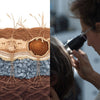
Recognizing damaged hair – Diagnostics for professionals
3 min reading time

3 min reading time
Learn how to professionally identify damaged hair . Discover the causes, visual signs, and test methods to scientifically analyze hair structure.
How do you recognize damaged hair? Diagnostics for professionals
Every successful treatment begins with a proper diagnosis. Damaged hair doesn't always look the same—it can appear dry, porous, brittle, or lifeless, depending on the type of damage. It's essential for a professional to understand exactly what's wrong with the hair structure , so you can treat it in a targeted manner instead of masking it.
1. What does “damaged hair” mean in scientific terms?
Damaged hair is hair where the cuticle (outer layer) has been compromised and the cortex (inner layer) has lost moisture, proteins or bonds.
✔ The disulfide bonds are weakened or broken.
✔ Lipids between the scales have disappeared.
✔ The hair fiber is no longer able to retain moisture or color.
The result: roughness, brittleness, lack of shine and elasticity.
2. The main causes of hair damage
Professional diagnostics starts at the source.
✔ Chemical damage – caused by colour, straightening, bleach, permanent or incorrectly performed keratin treatments.
✔ Thermal damage – prolonged use of straighteners or hairdryers above 180°C.
✔ Mechanical damage – excessive brushing, tight hairstyles, towel rubbing.
✔ Environmental factors – UV, salt, chlorine, air pollution.
✔ Internal factors – hormonal changes, stress, nutritional deficiencies.
Each form of damage leaves different traces – that is why personal analysis is essential .
3. The visual signs of damaged hair
Professionals recognize damage at the first observation:
✔ Dullness or loss of shine – open cuticle.
✔ Split ends – break in the cortex.
✔ Irregular texture – disturbed keratin bonds.
✔ Frizz and difficulty combing – loss of lipid film.
✔ Color fading – porous structure that does not retain pigment.
4. Diagnostic test methods in the salon
A professional hair analysis can be simple yet effective:
🔬 Elasticity test – gently pull on a wet hair strand:
Does it break immediately? → protein deficiency.
Stretches and doesn't bounce back? → lack of moisture.
💧 Porosity test – place a hair in a glass of water:
Sinks quickly → highly porous (damaged).
Floats → low porosity (healthy).
✨ Texture test – rub between your fingers: if it feels rough, the scales are open.
5. The role of diagnosis in treatment planning
Without a correct diagnosis, any treatment is a gamble.
✔ Analysis determines whether the hair needs hydration, protein or reconstruction.
✔ A keratin or amino acid treatment only works with an intact cortex.
✔ Overtreatment with proteins can worsen damage.
Professional knowledge makes the difference between temporary results and structural recovery.
6. Technological aids for modern salons
More and more salons are using digital hair analysis equipment with cameras and microscopic magnification.
✔ Comparison of cuticle status before and after treatment.
✔ Real-time measurement of moisture, elasticity and pH.
✔ Objective diagnosis – scientific precision in practice.
This is how hair care becomes data-driven and personalized .
Conclusion: observation is the beginning of healing
A professional who understands the language of hair can prevent damage before it becomes visible. Diagnosis isn't a step in the right direction—it's the foundation of craftsmanship. Because only those who know where the breakage originates can truly restore hair .